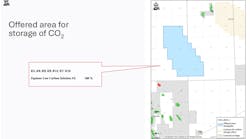Esso, Petronas to supply gas to Malaysia
Esso Production Malaysia and partner Petronas Carigali have signed a gas production sharing contract with Malaysian state oil company Petronas for the development of new gas fields and gas caps to supply 1.3 Bcf/d to Peninsular Malaysia through 2027. Under the terms of the agreement, Esso will operate the gas fields around the existing hubs at Jerneh and Lawit and in the existing oil production area. Petronas Carigali will operate the new Angsi Field and nearby platforms.Total investment in the project is estimated to be $5 billion. Gas sales of more than 12 Tcf from the gas production sharing contract and Esso's existing natural gas project and sales agreement are expected to supply about two-thirds of projected demand for the region for over 25 years.
Esso and Petronas Carigali are currently working on the development of the Angsi
oil field, which will mark the first large-
scale combined oil and non-associated gas development to be installed offshore Peninsular Malaysia. The development will include construction of a 72-mile, 320-in. gas pipeline from the field to the gas plants onshore at Kerteh. Startup is expected in 2002.
India: 48 blocks begin new licensing policy
India began road shows to solicit exploration bids for 48 blocks this month. The blocks on offer include offshore, onshore, shallow, and deepwater concessions. This is the first offering of blocks under India's New Exploration Licensing Policy (NELP). The offering was originally scheduled for late 1997 or early 1998, but was stalled due to disagreements over a petroleum tax code for the NELP and disagreements over royalty rates to states where the oil is discovered. However, government officials say that the controversy has been resolved and a new petroleum tax guide will be published along with the data and tender papers.The NELP was formulated with the government's budget for Financial Year 1997-1998 and is geared to attract foreign capital and advanced technology by offering global norms and equal terms between foreign and domestic companies. In order to further entice investment, the government also created the new petroleum tax code. The tax code under NELP makes provisions for:
- Payment of international price of oil for new discoveries
- Fixing royalty payments on an ad valorem basis
- 10% royalty for offshore crude
- 12.5% royalty for onshore crude
- 10% royalty for natural gas
- 6.25% royalty payment for deepwater exploration for the first seven years after commencement of initial production
- A 7-year tax holiday after commencement of commercial production for blocks in the northeastern region
- Exemption from customs duties.
Lundin completes 16th Bunga Kekwa production well
Lundin Malaysia has completed the latest and last Bunga Kekwa production well on Block PM3 CAA in the Commercial Arrangement Area between Malaysia and Vietnam in its latest drilling campaign. Well BK-A6 is the 16th well to be drilled on the block, and the fourth of the completed drilling campaign. BK-A6 was completed as a dual producer, but has not been brought onstream due to mechanical problems. The well has a capacity of about 3,000 b/d of oil, which will increase production on the Bunga Kekwa Field from 13,500 b/d to over 16,000 b/d of oil.The BK-A6 well was the most highly deviated well drilled to date, and was drilled to 14,859 ft, the longest reach of any well drilled on the block. The well also established the presence of oil in the northern limits of the field, thus confirming the presence of oil rims associated with the gas reservoirs. Lundin holds 41.44% interest in the block with partners Petronas Carigali (46.06%) and PetroVietnam (12.5%).
Japan-Sakhalin pipeline under study
A joint venture company is being established to study the feasibility of a natural gas pipeline from Russia's Sakhalin 1 Field to Japan. Japan Petroleum Exploration, Itochu, and Marubeni, in cooperation with Exxon, will establish the joint operation to explore routes and estimate construction costs for the pipeline, which is estimated to be completed in 2005.The pipeline is designed to be an alternative to supplying Japan's natural gas via tanker and as a way to meet the country's energy needs by reducing its dependence on oil. The gas from Sakhalin, which is expected to produce at peak rates of 6 million metric tons per year, would satisfy more than 10% of the Japanese demand.
Japan Petroleum Exploration will finance the majority of the joint venture company, with Exxon contributing 30% of the study cost, and Itochui and Marubeni holding minority interests. Sakhalin-1 is operated by Exxon, Sakhalin Oil Development Cooperation of Tokyo (of which Japan Petroleum Exploration, Itochu, and Marubeni are partners), and two other Russian constituents. Negotiations on the sale of the gas with Japanese firms, Tokyo Electric Power and Tokyo Gas, are set to begin soon.
Bass Strait
resumes flow Crude has begun to flow once again from Esso and BHP's Bass Strait Field offshore Australia. Oil was shut in for several months following an explosion at Esso's crude oil stabilization plant in Longford in the state of Victoria. Crude is now flowing at a constrained rate as the gas plants are re-commissioned and the facility is restored to full production capacity. Esso expects to achieve normal flow rates of over 200,000 b/d by the end of the month.Production was set to begin a month earlier, but was delayed by disputes with workers at the Longford plant. Disputes also arose with workers at offshore platforms, but did not disrupt start-up. Bass Strait is owned jointly by Esso Australia (operator) and BHP. The field supplies Longford with about 230,000 b/d of oil.
Copyright 1999 Oil & Gas Journal. All Rights Reserved.


